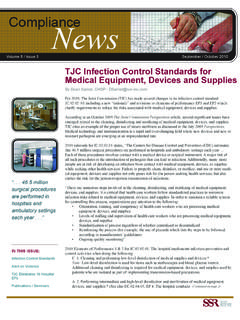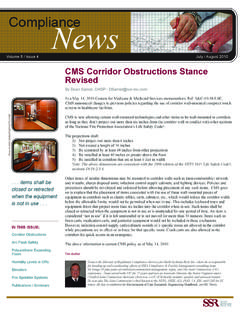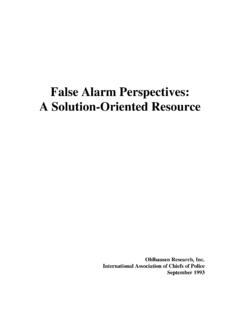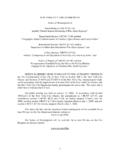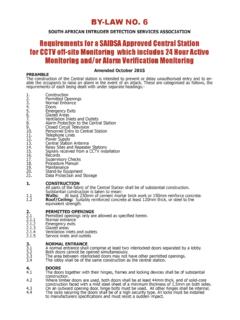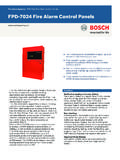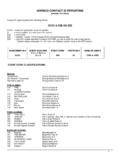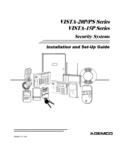Transcription of Location of the Master and Ancillary Fire Alarm …
1 Volume 8 / Issue 6 November / December 2010 Location of the Master and Ancillary fire Alarm Panels IN THIS ISSUE: Location of fire Alarm PanelsManual Transmission of fire Alarm SignalsAccreditation Survey FindingsLSC Specialist SurveyorsPublications / SeminarsBy Dean Samet, CHSP - a July 2010 Environment of Care News article entitled, Ensuring Effective fire Alarm and Automatic Sprinkler Systems, The Joint Commission says that there has been some confusion among health care organizations regarding the requirements for the Master fire Alarm panel Location . Standard , EP 2 states: The Master fire Alarm control panel is located in a protected environment (an area enclosed with 1-hour fire -rated walls and -hour fire -rated doors) that is continuously occupied or in an area with a smoke detector.
2 (See also , EP 5.) (For full text and any exceptions, refer to NFPA 101-2000 ; and NFPA 72-1999: and ) Standard , EP 3 states: The remote Ancillary annunciator panel is in a Location approved by the local fire department or its equivalent. (For full text and any exceptions, refer to NFPA 101-2000 ) Per the above TJC standard EP, an organization appears to have two choices for the Location of the Master fire Alarm control panel: 1. A protected area (one-hour construction w/ 45-minute fire -rated door assemblies) that is continuously occupied; or,2. An area with a smoke detector.
3 The article goes on to explain that EP 2 shown above does not require an organization to build a pro-tected area if they don t already have They may simply choose to install a smoke detector near the Alarm panel to satisfy this EP s requirements. The Master fire Alarm panel is often located in the hospital s switchboard area or some other continuously staffed Location . Organizations must also have a secondary panel (remote Ancillary annunciator) that is protected to ensure that the fire Alarm monitoring system will still function even if there is a fire in the area of the Master fire Alarm panel.
4 According to this article, organizations should locate their secondary panel in another continuously staffed Location , such as a nursing station or perhaps a maintenance shop. TJC goes on to say that the Location of either panel, especially if the panels are to be moved or relocated for whatever reason, should be verified for appropriateness with the local fire department or authorities having jurisdiction (AHJs).. an organization appears to have two choices for the Location .. Smith Seckman Reid, Inc. would like to wish our readers an Abundant Thanksgiving, a Blessed Christmas and Holiday Season, and a Happy New Year!
5 Look for our next issue of Compliance News in January the July 2010 Environment of Care News article Ensuring Effective fire Alarm and Automatic Sprinkler Systems, The Joint Commission (TJC) reintroduced a manual method of fire Alarm transmission policy. This policy is meant to be applied when the four traditional methods of transmitting fire Alarm signals to the local fire department cannot be achieved per the 2000 NFPA 101, Life Safety Code (LSC), Section Emergency Forces Notification, which in turn references the 1999 NFPA 72, National fire Alarm Code.
6 The four traditional methods consist of: 1. Auxiliary Alarm system: Direct connect to servicing fire department (NFPA 72-1999, Chapter16-6) 2. Central station connection: Managing of signals by contracted service (NFPA 72-1999, Chapter 5-2) 3. Proprietary system: fire Alarm systems that serve contiguous and noncontiguous properties under one ownership, with appropriately trained staff (NFPA 72-1999, Chapter 5-3) 4. Remote station connection: Alarm monitoring center that sends signals to the public fire service communications center (NFPA 72-1999, Ch.)
7 5-4) There may be times and circumstances where a direct-connect to the municipal fire department is not available. This is where TJC s manual method of transmission may be a viable alternative. Such methods are allowed, with authority having jurisdiction (AHJ) approval, per the Exception to LSC Section The following detailed policy information is taken from the March 2008 The Joint Commission Perspectives , Volume 28, Before using the TJC alternative manual method, the healthcare organizations must first demonstrate compliance with each of the following requirements: 1.
8 fire Alarm signals must be received at a supervised Location in the healthcare facility. Only a single, permanent, central Location such as a telecommunications center or a safety/security office may be used. Multiple annunciator panels throughout the facility may also be used. However, the official Alarm -receiving and -transmitting Location must be a single, permanent Location . 2. The supervised Location must never be left unattended. No staffing requirement is stipulated, but at least one person must be present at all times. If personnel will be performing multiple job functions, it may be necessary to increase staffing.
9 Responding to fire alarms must take precedence over all other assigned job The supervised Location must be protected in the same manner as a hazardous area, referenced in NFPA 101-2000, Sections and This affords a basic level of protection to both the operators and the equipment at the supervised Location . At a minimum, the supervised Location must be in a totally enclosed room (or equivalent). If the room is not equipped with sprinklers, all walls, doors, and other penetrations into the room must have a one-hour, fire -resistance rating. If the room is equipped with sprinklers, the walls, doors, and other penetrations into the room may be unrated assemblies but must prevent the transmission of smoke into the The supervised Location must contain the appropriate equipment to receive fire Alarm signals.
10 The equipment may be either the Master fire Alarm control panel or an auxiliary annunciator panel. Annunciator panels must at least have the capacity to identify the Location and type of Alarm as the Master fire Alarm control panel. When a fire Alarm signal is received at the supervised Location , it must activate both a visual and audible signal at that Location . The signal must be clearly distinguishable as the fire Alarm signal and must be seen and heard above all other alarms or signals received at that A log that records all status changes to the fire Alarm system must be maintained in the supervised Location .

